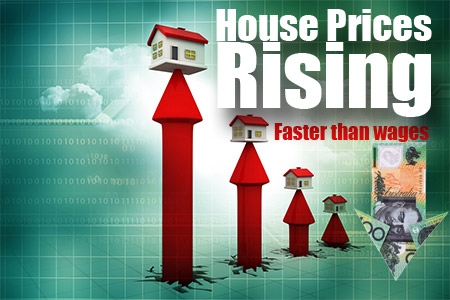Why are housing prices rising faster than wages?

1 in every 7 tax payers now own a rental property. First home buyers now find themselves competing with investors utilising Australia's negative gearing laws and foreign investors attracted to the Australian Real Estate market.
This puts the price of houses up in Australia.
Investor demand is increasing both prices and demand for housing in Australia.
Elboing people out of the way - keeping renters in the rental market treadmill as house prices rise (and rents).

Negative Gearing
Negative Gearing has been around since 1922 - it is where you are allowed to claim losses against your taxable income, thus making investing attractive. It started as a way to encourage housing development.
ABC Life matters 19-11-2014 with Peter Martin Economics Editor, The Age
"A million and a quarter Australian investors benefit from negative gearing. The tax breaks cost the government billions of dollars a year in lost revenue and critics say that negative gearing pushes up the price of houses making it even harder for first home buyers. So is it time to get rid of negative gearing or would it cause a major contraction in rental properties?"
Home Loan Sizes Growing
HOME loan sizes have jumped between 50 and 100 per cent nationally in the past 10 years.
Tip: test what you can afford at higher interest rates before accepting the lower rate - do not assume circumstances wiil not change.
7% of investments are now for new houses - leaving 93% to bid up the price of existing properties.
Invester Lending New vs Existing Construction up to 2010
Souce: http://en.wikipedia.org/wiki/File:Investor_Lending_-_new_vs_existing_to_Feb_2010.pdf
Although investors are not supposed to use a home mortgage for an investment property, it is happening anyway in Australia.
Recent information from the Reserve Bank: 50% of new loans are for investment property - this figure used to be 20%, showing increased pressures on the housing market.
SEARCH ARTICLES
Recent Posts
- Jul, 22, 2025
- May, 6, 2025
Diversity on Boards
- Apr, 11, 2025
When does asbestos become dangerous in your home?
- Jan, 23, 2025
How Design Aesthetics Shape Perceived Value
- Dec, 10, 2024
Impact of Inflation on First-Time Buyers
- Nov, 4, 2024
How to understand and check your credit score
- Sep, 19, 2024
Buying off the plan? Beware of sunset clauses
- Jul, 5, 2024
Essential Workers Explained
- Jun, 13, 2024
Ozone Generators to remove Mould
- Feb, 19, 2024
Massive tax handouts for property investors
- Feb, 16, 2024
Body Corporate sinking fund - QLD
- Feb, 2, 2024
Scaffolding Safety
- Sep, 20, 2023
Learning to Negotiate
- Jul, 11, 2023
Pension Age Rises to 67
- May, 18, 2023
Becoming A Registered Builder In Australia
- Apr, 17, 2023
Forced Sales - Queensland - 75% Rule
- Dec, 6, 2022
Petty Landlords & Negative Gearing
- Sep, 19, 2022
The benefits of shade sails for your home
- Jul, 27, 2022
Termite Swarmers Season
- Jun, 22, 2022
Fear of missing out driving inflation
- Apr, 28, 2022
Australia's Rental Crisis
- Mar, 7, 2022
Should you buy a home with Termite damage?
- Mar, 3, 2022
Tactics to reduce body corporate disputes
- Jan, 25, 2022
Globalisation - The Hedgehog & The Fox
- Nov, 2, 2021
Revealed: Top 10 areas to avoid buying
- Oct, 28, 2021
Is that house protected against termites?
- Sep, 15, 2021
Tree Changers & Sea Changers
- Aug, 12, 2021
COVID 19 and Body Corporate Responsibilities
- Jul, 29, 2021
Tenants beware of rental rewards schemes
- Jun, 25, 2021
Sunshine Coast versus Gold Coast
- Jun, 23, 2021
Your superannuation and your home
- Jun, 11, 2021
How many properties sit empty?
- May, 10, 2021
What Returns could I make from Property Investment
- May, 4, 2021
Real Estate Agents and Property Managers
- Apr, 20, 2021
Why You Need A Termite Inspection
- Mar, 19, 2021
SEO for Real Estate websites
- Mar, 18, 2021
Three Reasons Why Your Home Needs Data Cabling
- Mar, 16, 2021
Smoke Alarms: What you need To know in QLD
- Dec, 10, 2020
Pre-purchase Electrical Inspection
- Dec, 4, 2020
Why should I drink Adelaide Hills Wines?
- Aug, 26, 2020
Amalgamation of Strata-titled Lots for Development
- Jul, 28, 2020
Adelaide Hills a unique region
- Apr, 28, 2020
Ozone Generator in Your Home
- Apr, 21, 2020
Air conditioning cleaning
- Apr, 14, 2020
Housing Affordability in Australia
- Apr, 6, 2020
Security Systems
- Mar, 31, 2020
Termites and protecting the home
- Feb, 27, 2020
Printing for the Real Estate Industry
- Nov, 12, 2019
Beware of Property Investment Spruikers
- Oct, 31, 2019
Prices for Home Alarm Monitoring
- Oct, 9, 2019
House and Land packages best investment
- Oct, 1, 2019
The 'Scourge' of Underquoting
- Oct, 16, 2017
Professional Pest Control
- Sep, 29, 2017
Built in Wardrobes
- Jul, 9, 2015
Pool Inspections Queensland
- Jun, 25, 2015
Negotiating your purchase with the Inspection
- May, 12, 2015
DIY Move or hire a removalist company?
- Jan, 17, 2014
The Friendliest Real Estate Agents
- Jul, 23, 2013
A thorough Building and Pest Inspection
- Sep, 28, 2012
How to Compare Home Loans
- Jan, 25, 2012
Southport Real Estate


